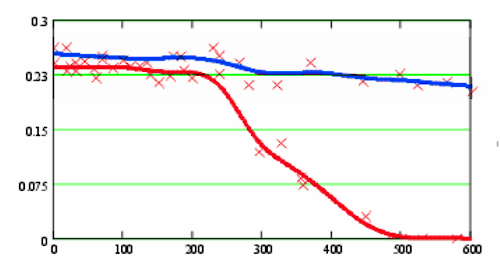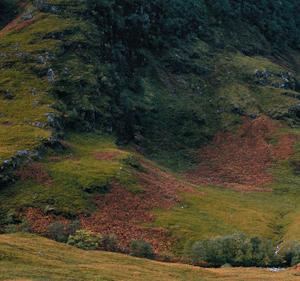Colour & Digital vs Film Resolution
Whenever digital photographers talk about large format, they end up getting obsessed about resolution. Most large format photographers know that this isn’t the main reason the large format experience is so enticing (i.e. perspective and focal plane control, the huge view, the luscious nature of film, etc) but being as it gets talked about so wrongly in so many places, I thought I’d get my own geeky view in. First of all let’s review some of the existing literature on the subject.
Probably the best known is Mr Reichman’s Luminous Landscape essay on the subject, where he compares a medium format camera with a Canon 1Ds, 11Mp, with a Pentax 67. He comes to the conclusion that the 11Mp camera has equivalent if not greater resolution than the digital. Well Michael gets a few things wrong, the most basic of which is effectively down sampling the medium format image to match the resolution of the DSLR.. duh! If you want a rough idea of where he’s going wrong, compare the images where he looks at noise content, you’ll see the reflections are more details and the edges of the window frames show 3d modelling, not blurred anti-aliasing. And this wasn’t using a drum scanner or medium format hires scanner (like a Nikon).
Moving on to someone who appreciates film and digital, hopefully who has a non-biased viewpoint, Ken Rockwell has an excellent article. Ken quotes a 25Mp count for 35mm film but having looked the Clarkvision website who has an enormous amount of information on the subject, it seems that 15Mp is about the limit for line resolution, read more about the capabilities of large format here. The surface area of 35mm film is 864mm2, 645 film is 2090mm2, 6×7 is 3920mm2 and finally 4×5 is 11520mm2 … This makes the scaling factor for 645 is 2.4x, 6×7 is 8.4x and finally 4×5 is 13.3x. So according to the very thorough research by Mr Clark, we should need 199Mp in order to reach the ultimate limit of high resolution slide film. However, bear in mind that various other aspects of the imaging chain mean that this ultimate resolution for 4×5 isn’t quite acheivable.
Charles Cramer does a comparison of 4×5 and a 39Mp digital back on the luminous landscape website where he says that a P45 ‘almost’ equals 4×5. However, his definition of almost isn’t quite almost the same as my almost definition. Take a look at the close up leaf comparison and look at the vein patterns and also look at the texture of the wall in the background. This difference looks to be more than just the difference between maybe 39Mp and 42Mp. It looks to me like the difference between 39Mp and 80Mp or more.
The problem with comparing film and digital is that they are effectively doing two completely different things. To understand why we need to know a little bit about how digital works. Each pixel in a digital camera can only be green blue or red. i.e. the pixels are essentially monochrome. The colour information comes from the fact that the pixels are distributed around the sensor in different colours and ‘clever’ algorithms try to work out the missing information. Below is an example of a bayer array (the name of the sensor pattern that is used in most cameras). Every four pixels has a block of two greens, a red and a blue pixel. The reason for two green pixel is because it was worked out that most textural, luminosity information can be worked out from green data and the colour information can be interpolated from the red and blue data (here for examples). This is pretty cool, it means that for each square of four pixels, you can work out the luminosity resolution using two of them and the colour information from the remainder. Oh! Hang on! That means that you only have half of the pixel count to work out the luminance data and only enough information for accurate colour every four pixels. So a 16Mp is actually an 8Mp luminosity camera combined with a 4Mp hue camera. But digital cameras look like they have more resolution than this! Well, sort of. RAW conversion software then uses various edge detection algorithms to try to increase the apparent resolution. So you probably get some symptoms of a 14Mp camera, maybe the occasional edge that looks like a 16Mp camera but mostly probably a 10-12 Mp camera. So perhaps digital does have some resolution after all. Well… no. What is effectively happening here is digital upsampling. You can apply this sort of edge detection and upsampling to a film shot just too.
A thorough paper from the Stiftung Warentest institute measured the colour resolution response (effectively separating out the saturation component of the picture and working out it’s resolution) and produced the following graph showing how colour resolution falls as the frequency of detail increases. The blue line shows a foveon sensor (which works like film) and the red line shows a bayer mosaic’ed sensor. As you can see, the camera has a half of the linear resolution of the film/foveon equivalent. This equates to a quarter of the number of pixels. You can see the full paper here

What is very important about that last paragraph, and something that is often missed when looking at comparisons like this, is that the colour resolution of a digital camera is only half of the luminosity resolution. For most instances, this doesn’t matter as the ‘upsampling’ algorithm uses all sorts of cleverness to make sure colour ‘looks’ good. However, it does show up along colour edges and also, most importantly for landscape photography, in high frequency colour details, i.e. colour texture. For example, a distant field of grass and flowers or the tecture of moss on wood. The colour of leaves in an autumn tree, etc., etc. How does this lack of colour resolution affect real world photographs? Well, a good example is in this show below where we compare a 5×4 large format transparency with 5D file. Now I’m not comparing resolution here, the 4×5 transparency is way, way better than the digital so for these purposes the 4×5 is equivalent to the ‘real world’ view.
This is a pretty extreme example and I plan to do some further tests to see how this effects some more modern cameras (hopefully a test of a phase one back against a large format transparency at some point). Anyway, how does this lack of colour resolution translate into real world landscape photography. Well, for one, don’t expect very fine colour texture to appear correctly in digital images. If you do have fine texture, you will have to live with the fact that your pictures won’t blow up as well as they might otherwise.
As far as how many megapixels does a colour large format transparency have? Well, if we’re looking at a ‘digital friendly’ picture, probably around 80Mp for the typical shot, possibly 100+Mp with a good lens and great technique. With a highly textural picture, we could be talking about 180+Mp. This probably means that for an Imacon scan of a large format transparency, you probably have around 50Mp ish (but lacking in some colour detail).
We can also learn a little from the work at the Gigapixl Project who worked out a couple of things (along with an estimate of 12Mp as the equivalent of a 35mm picture), one of which was that 360dpi is the maximum a typical human can resolve in print. This is handy as it gives us an ‘optimum, eye resolution limited’ print size for various sources. The Imacon scanned print is optimum when printed at 17×21 inches.. which is pretty handy given the size of most affordable printers! But it also means that if you get a good transparency and drum scan it, you can get an eye resolution limited print of 20×25 inches. Of course, we’ve also learned that digital cameras, ‘cheat’ to get a better resolution and it ‘works’ fairly well. So we can do the same with our digital prints to get an increase in maybe 30% linear resolution (for ‘most’ pictures where things like ‘edge detection’ can work).
This post will be continued when I get a chance to play with a digital back…  Let me know if you’ve learned anything from this or if you think I’ve missed something.
Let me know if you’ve learned anything from this or if you think I’ve missed something.
UPDATE: A good example of raw comparisons and how they go wrong here and here
UPDATE: Ian Scovell has pointed me towards an excellent film comparison with digital on Marco Boeringa’s website which supports the 15+ Mp for a 35mm transparency idea – possibly even more.
UPDATE: I found a good example of the difference between pixel level resolution and bayer array resolution at the Foveon website. Foveon uses a technology where each pixel records all three components. The comparison is here and the background on Foveon is here
UPDATE: Another example for a Luminous Landscape reader that falls into the trap if testing monochromatic, line images where raw converters and bayer sensors are at their best here
UPDATE: A great example of the resolution capabilities of a film camera here. 35mm vs digital M7 vs M9 using Spur Nano Edge black and white film here

12 Responses to “Colour & Digital vs Film Resolution”